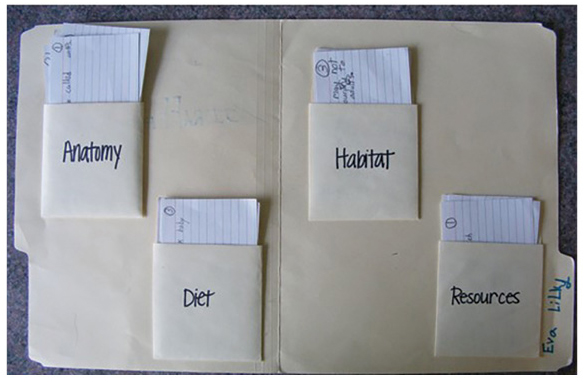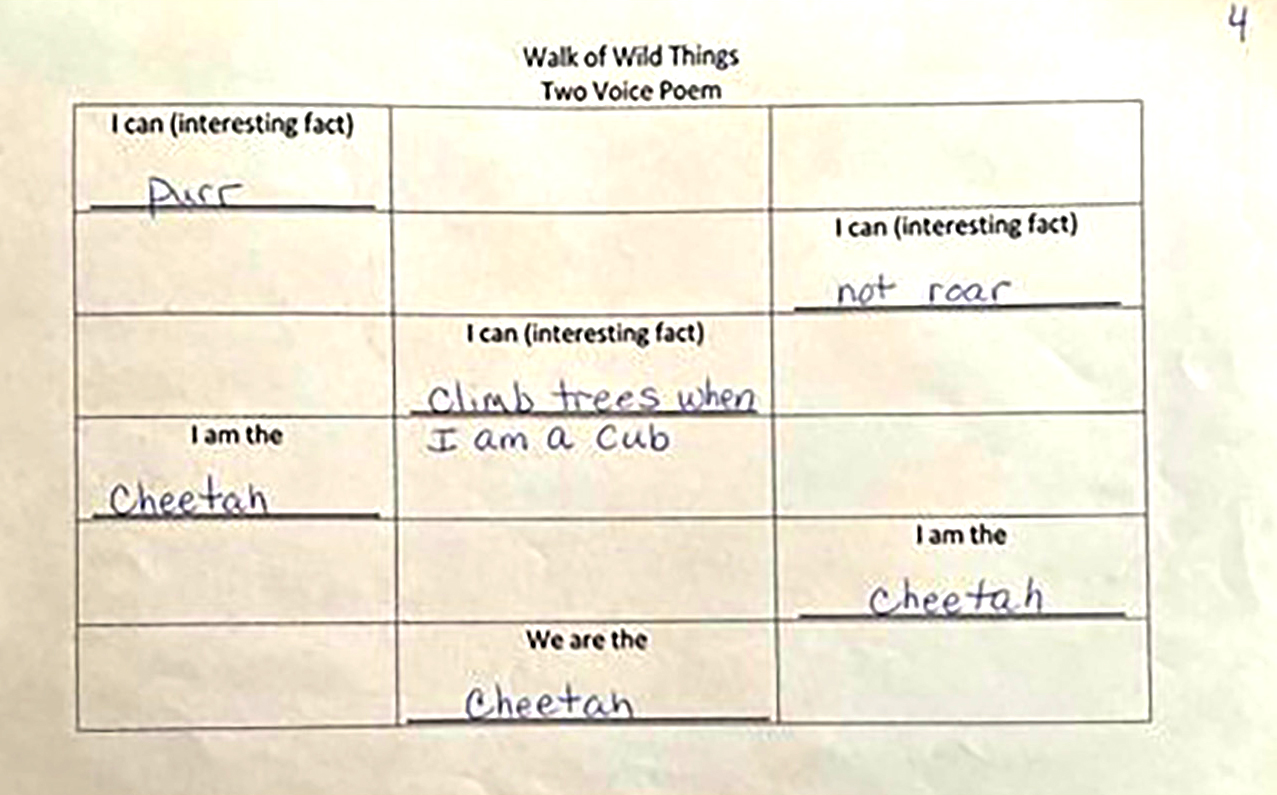cross-curricular connections
Walk of Wild Things
A cross-grade collaboration teaches first- and third-grade students research skills
Science and Children—September/October 2022 (Volume 60, Issue 1)
By Melinda Hammerschmidt, Rebecca Crowder Dischner, and Dea Borneman
“How many bones does it have?” “Is it deadly and if so, how deadly is it?” “What does its skin feel like?” “Why does a baby deer have spots?” These are a few of the questions that students asked during an introductory session for a cross-age unit between third- and first-grade classrooms. This “Walk of Wild Things” unit used a theme of wild animals to engage students as they gained research skills to investigate the animals. The third graders practiced these skills within the classroom and then modeled them for their partners. Each of the lessons were taught during a morning communication arts block over a four-week timeframe, for approximately 30 to 45 minutes every day. The cross-grade collaborative classroom was found to promote learning and fostered positive relationships that supported a stronger school culture and community. Many of the student partners developed genuine friendships, went to the local zoo together, and continued interacting after the project was completed. Throughout the unit, the classroom teachers and the school librarian worked in collaboration to observe the students’ ability to work with partners and assess the student products.
Lesson Examples and Procedures Week 1, Day 1: Two by Two
We began by pairing third-grade students with first-grade research partners. Students were placed together based on reading Lexile levels, along with some consideration to personalities. Students that had greater difficulty with reading, concentrating, staying on task, or other unique challenges were paired with stronger readers and writers. Then, we worked on introductory activities together as a combined class before moving into small-group and partner work, which allowed us to observe students’ behaviors and how they worked together. The groups were kept flexible before assigning the animals, so we were able to make changes to partners if needed.
To begin, students were shown photos of meerkats and shared what they believed these animals were doing and communicating to each other. Further discussion involving the meerkat photographs was based upon prior knowledge from science classes, where the first graders had learned about animal traits, characteristics, and how their senses aid them in their environment. Third-grade students learned in science that some animal characteristics are inherited from their parents, while others are affected by their environment and habitat. Our purpose in sharing the meerkat photographs was to inspire the students to think about the unique features of this animal. The classroom teachers guided a discussion about the importance and interdependence of the animal kingdom plus characteristics of the meerkats and how they use their senses to survive, communicate, and protect themselves. Students learned how the absence or abundance of one animal affects another animal’s habitat. As students shared the information with the whole group, the questions and observations were listed and discussed. During the discussion, accurate details were provided about the meerkats, and all the students were excited to share what they had learned with their research partners. Next, the classroom teachers provided a list of animals that the students could explore, and then the research partners ranked their top five choices. An extensive list of animals was developed by the classroom teachers and the librarian prior to the beginning of the unit, to ensure appropriate reading level resources were available.
Week 1. Day 2: Questions and Categories
The third-grade teacher began modeling research and note-taking skills with her class. The students participated in a lesson about research questions by breaking into groups and brainstorming questions that they could use to investigate the animals. Next, the class discussed how they could categorize the various questions to organize the information. Categories determined by the class included habitat, diet, and anatomy. Using a new chart in SMART Notebook, the students then sorted each question into its proper category. At their next meeting, the third graders shared what they had learned with the first graders, then they formulated questions together and practiced sorting them into categories.
Week 1. Days 3–4: Animal Assignments and Literacy Integration
The first- and third-grade students were brought together again to learn which animal they would investigate. In a fun naming ceremony, the teachers and librarian entered the classroom wearing animal headbands while “Wild Thing” by Chip Taylor played in the background. To add to the excitement, as each group of research partners were called up, the teachers and the librarian acted out or pantomimed the animal, and the students guessed which “wild thing” they had been assigned! The fun continued as the partners received library books about their animal and a research folder that had four labeled pockets—anatomy, diet, habitat, and resources—glued inside (Figure 1). After reviewing research questions from the previous day, the teachers engaged the students by discussing and modeling how to identify important information when conducting research. They also worked on determining the difference between important and interesting facts and that they are not necessarily the same. The research questions were used to determine which facts were important. The rest of days 3 and 4 were spent looking at books and reading about the animals with collaborative partners.

Library pockets are labeled and hot glued into place prior to giving to students.
Week 1. Day 5: Animal Exploration
The classroom teacher and the librarian taught the third graders to complete their fact and resource cards by modeling how to read and then record information. The National Geographic Website for Kids (see Online Resources) worked well for this lesson and also provided students with an online resource. The students were taught to record one fact per note card, and then filed each card into the appropriate category pocket (anatomy, habitat, or diet). Next, they learned how to complete and code a resource card to show where they had found their facts. Each resource was assigned a number, and each fact from that resource received the same corresponding number. Students were encouraged to write thoughts on the fact cards to demonstrate knowledge and identify pertinent information. For online resources, students recorded the name and URL of the website. The third graders modeled these research strategies for their younger partners, then helped the first graders with note taking and reading the information. Later in the day, the first-grade teacher reviewed these skills with her class.
Weeks 2–3: Let the Research Begin
The students conducted research each day as they worked together to find, record, and categorize information. The classroom teachers and the librarian monitored student work to ensure adequate progress throughout the project and cooperation between research partners. The students began writing paragraphs about their animal by using the fact cards as a graphic organizer. Student paragraphs were not the same length. Some of the groups wrote shorter paragraphs; however, they were encouraged to add detailed illustrations or verbally use their written cues to share the information with others. They organized the cards into a logical order and then wrote a rough draft.
The writing was completed as a cooperative activity between the research partners with guidance from the classroom teachers and librarian in a small group setting. Due dates for each paragraph were about four days apart to ensure adequate progress toward completion. This timeframe provided additional time for research, as well as allowing students who had been absent to complete their cards.
The learning progressions vertically aligned the foundational skills that the third graders taught to the first graders as they obtained and refined their knowledge. The unit activities provided students with a chance to obtain, evaluate, and communicate information beyond a basic report. Students explored different kinds of animals and how living things coexist on land and water in various conditions and habitats. Students examined characteristics of an animal, delved deeper into how animals grow, communicate, and how their environments and habitats can change. Research partners also explored how the animal’s anatomy helps the animal survive, grow, and change to adapt to their habitat, along with many other fun and unusual facts.
Week 4: Putting the Pieces Together
After all paragraphs were written, the partners created illustrations to correspond with their writing and input both the pictures and paragraphs into an online book app called Book Builder. (Figure 2). The book included one page for each of the following: cover, introduction, habitat, diet, anatomy, closing, and resources. Next, the partners recorded themselves reading their book using Audacity. During this week, the students also created information for a tri-fold presentation board (Figure 3). The third graders typed the information for the board on separate sheets of paper (panels). The presentation boards and panels were then sent home with the first graders, who worked with their parents to assemble the panels onto the boards.

Students input information onto the design page in Bookbuilder.

Students created a presentation board with their parents for the night of oral presentations.
Culmination of the Unit
Throughout the unit, the classroom teachers and librarian worked with the students on reading, research, writing, collaboration, and oral presentation skills. The final component of the unit was an oral presentation using a two-voice poem, written in first person. (Figure 4). Students dressed as their animal or wore dress clothes for the evening performance. They presented their two-voice poems and stood in front of tables that displayed their presentation boards. Copies of the online books were printed and displayed on the tables.

Sample pages of a two-voice poem.
Evaluation was ongoing throughout the unit. The teachers observed the students’ cooperative learning skills and engaged the students within small- and large-group discussions. Student work samples were evaluated throughout the process using a variety of tools. Additionally, students were provided the opportunity to self-evaluate (see Supplemental Resources).
Teacher Collaboration and Efficacy
This cross-grade collaboration provided time for the teachers to work together in facilitating learning and increased teacher efficacy. Time spent on planning and defining goals allowed the project to move away from being primarily teacher-driven to a more student-led project. The collaborative nature of the unit provided time for the sharing of ideas and questions among the student partners, which helped to engage all students in the learning process. Appropriate grade-level learning skills were instrumental in the success of the Walk of Wild Things unit. The librarian identified books at the appropriate reading and interest levels for the students. She reinforced research skills, such as citing sources, using a table of contents or an index, and identifying additional resources during weekly library classes.
We found this cross-grade unit allowed students to practice reading for information, writing, researching, collaborative skills, and making oral presentations. The third graders demonstrated enhanced research and process skills that were carried forward into other end-of-year projects. The first graders learned how to begin applying knowledge for research and presentations. In closing, we found that multi-age collaboration was an enjoyable teaching tool that increased teacher efficacy, built student knowledge, and strengthened students’ ability to work cooperatively with others.
Supplemental Resources
Download the rubric and self assessment at http://melindahammerschmidtglsfirstgrade.weebly.com/walk-of-wild-things-supplemental-resources.html
Online Resources
Audacity: www.audacityteam.org/
Book Builder: bookbuilder.cast.org/
Enchanted Learning: https://www.enchantedlearning.com/
National Geographic Website for Kids: Animals: https://kids.nationalgeographic.com/animals
San Diego Zoo: https://sdzwildlifeexplorers.org/animals
SMART Notebook: https://legacy.smarttech.com/en/products/education-software/notebook/download/basic
Melinda Hammerschmidt (MelindaHammerschmidt@MissouriState.edu) is a first-grade instructor, and Rebecca Crowder Dischner is faculty emeritus, both at Missouri State University - Greenwood Laboratory School in Springfield, Missouri. Dea Borneman (DeaBorneman@MissouriState.Edu) is a professor of library science at Missouri State University.
Biology Interdisciplinary Life Science STEM Elementary


